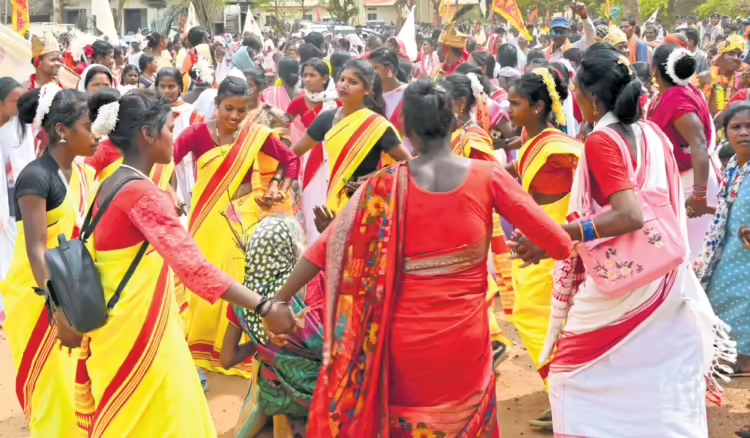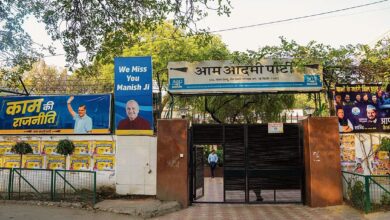Battle in Bastar between Congress and BJP even
The first round of voting on April 19 will feature a fierce struggle between a relatively unknown new face from the BJP and a veteran Congress politician for the Maoist-affected Bastar Lok Sabha seat in south Chhattisgarh. In addition to determining the political fate of the contenders, the elections in the reserved seat with a mostly tribal population will assess the capacity for leadership of the state party bosses from the Bastar area, Kiran Dev (BJP) and Deepak Baij (Congress).

The BJP is putting a lot of faith in PM Modi’s “magic.” The party thought that the religious conversion issue helped them win almost half of the 12 assembly seats in the Bastar zone in the 2023 Assembly votes.
Mahesh Kashyap, a prominent member of the Vishwa Hindu Parishad (VHP) and a well-known “Hinduvta” in the community, was selected by the saffron party, perhaps depending on this image.
Battle between Congress and BJP in Bastar even
Rahul visits Bastar and declares that Congress would carry out a caste study.
In Bastar, people are acquainted with Congress candidate Kawasi Lakhma. She was the excise minister in the administration headed by Bhupesh Baghel and a six-time MLA from the Konta seat. His words are infamous for igniting arguments in order to stay in style. Three First Information Reports (FIRs) have been filed in Bastar against him since the model code of conduct was implemented.
Before the campaign concluded on Wednesday, Lakhma and Kashyap both made a strong push across the constituency in the last days of the campaign.
Throughout his election campaign, Kashyap often used the phrase “Your vote is for Modi, not for me” while hammering home the “Modi Ki Guarantee.” Appealing to the sensibilities of the local tribe, Lakhma restated the five promises made by the Congress to women, farmers, youths, and destitute tribal people. During the election season, the BJP brought religious conversion problems into state politics.
The danger posed by the Maoists was clearly seen as a concern in the restive Bastar region, which encompassed most of the hypersensitive regions. Approximately 40% of the constituency was said to include Maoists. Bastar is reportedly home to the proscribed outfit’s lone military regiment.
Bastar has eight seats for the legislature. Due to security concerns, certain voting places have been moved: 99 in Bijapur; 42 in Dantewada; 42 in Konta; 41 in Narayanpur; and 9 in Chitrakot.
Nine helicopters have airlifted the polling staff for 156 booths in very sensitive and hostile terrain.
It’s interesting to note that, in spite of the Maoists’ call for a boycott of the polls and the ongoing perception of threat, voter turnout in the Bastar region increased by 27% in 2019 compared to 2004, the year that Chhattisgarh held its first parliamentary elections following the state’s division. Voter participation was 43.3% in 2004 and increased progressively to 47.3 (2009), 59.3 (2014), and 70.3% in 2019. With more than 60% of its population being tribal, Bastar has 1,086 female votes for every 1,000 male voters.
The week before, Prime Minister Narendra Modi and Congress leader Rahul Gandhi spoke at large rallies from the tribal heartland of Bastar, where Adivasi votes were crucial in the four scheduled tribe reserved seats of the state.In the Bastar constituency, the BJP maintained its winning streak from 1999 to 2014. In 2019, the Congress took the seat.
Battle in Bastar between Congress, BJP, and even Chhattisgarh: Save for Bastar in 2019, the BJP has always held five reserved seats.
Together, the paramilitary forces and the Chhattisgarh police have devised tactics and deployment plans to guarantee that Friday’s election is free, fair, and peaceful.
More than 80,000 people would be sent out, including 350 paramilitary companies, each with 80–90 jawans. Over the course of the previous five years, up to 75 additional operational security base camps have been established in key Bastar zone areas.
According to Sundarraj P, the inspector general of police for the Bastar range, “the presence of more camps as a development bubble led to building infrastructure, gaining trust of local tribals and diminishing the impact of Maoist strongholds.”






